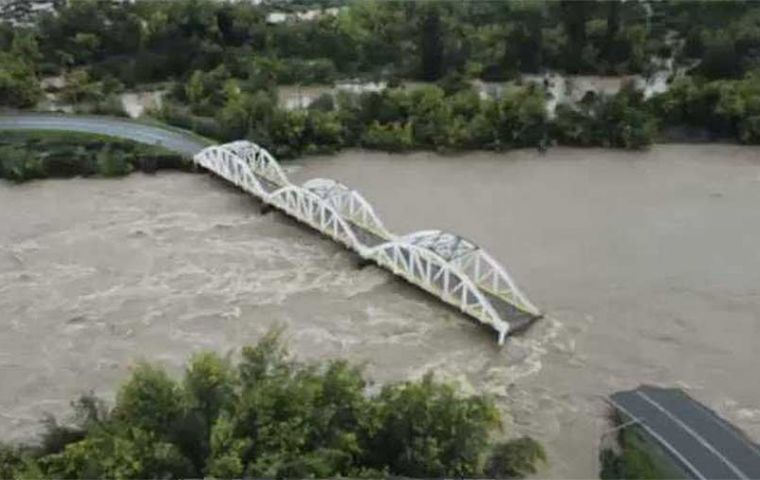MercoPress. South Atlantic News Agency
Heavy rains in Chile leave 2 people dead, thousands stranded
 The cutting of a bridge in the Maule region left just over 24,000 people stranded, Monsalve explained
The cutting of a bridge in the Maule region left just over 24,000 people stranded, Monsalve explained Heavy rains in central and southern Chile have resulted in at least two people dead plus thousands stranded or taken to shelters, it was reported Monday. The victims were a driver who was hit by a tree and a firefighter who was killed Sunday when trying to rescue a lamb from the river in the town of Cañete, in the Bíobio region, some 550 kilometers south of Santiago, Undersecretary of the Interior Manuel Monsalve said.
The number of stranded people went up from 5,500 to almost 30,000 due to the cutting of a bridge in the Maule region, around 250 km south of Santiago. The loss of connectivity at the 3 Arcos Bridge, in the province of Linares, “left just over 24,000 people isolated due to the bridge, which substantially modified the number of isolated people at the national level,” Monsalve explained.
According to the Committee for Disaster Risk Management (Cogrid), about 19,000 people have been evacuated as a preventive measure, 169 houses have suffered major damage and there were 25 areas under red alert due to the threat of overflowing. In addition, classes have been suspended in some twenty localities in the central-southern part of the country.
“As of today, August 21, rainfall will be concentrated between the regions of O'Higgins and Bíobio, and we will have rainfall in Valparaíso and Metropolitana, which will be concentrated mainly on August 22”, said Monsalve.
In this scenario, the Chilean Government decreed a state of catastrophe and emergency Monday for the regions of O'Higgins, Maule, Ñuble, and Bío Bío.
“I communicate to you that I have instructed to declare a Constitutional State of Catastrophe from O'Higgins to Biobío. This allows greater ease and fluidity of resources, having all the necessary safeguards,” President Gabriel Boric Font said after 423 people were sheltered, 26,297 were stranded, and 33,895 were evacuated, according to the authorities. In addition, 658 houses suffered minor damage, 207 major damage, one was destroyed, and 65 others were under evaluation.
The rainfall, which began on August 18, caused the Cayucupil River to rise in the Biobío. The National Service of Geology and Mining (Sernageomin) said the probability of occurrence is maintained in different sectors between the regions of Valparaíso and Biobío.




Top Comments
Disclaimer & comment rulesCommenting for this story is now closed.
If you have a Facebook account, become a fan and comment on our Facebook Page!